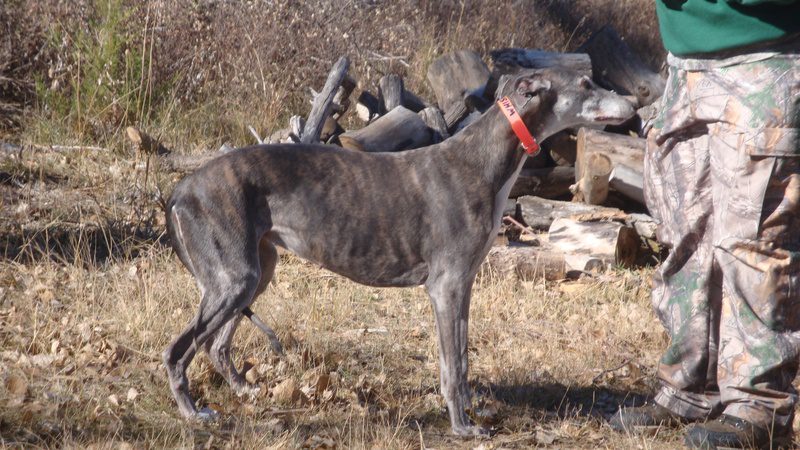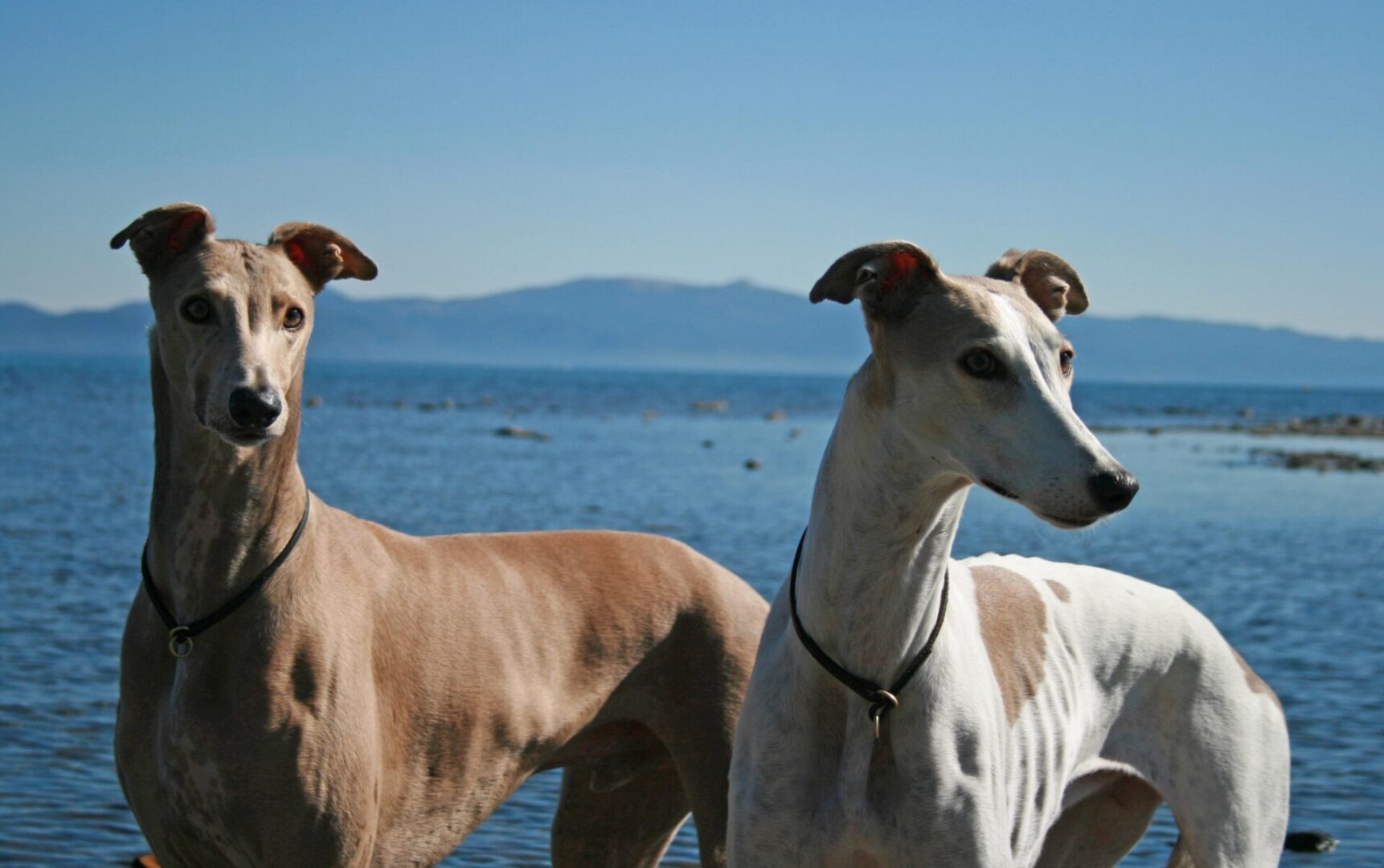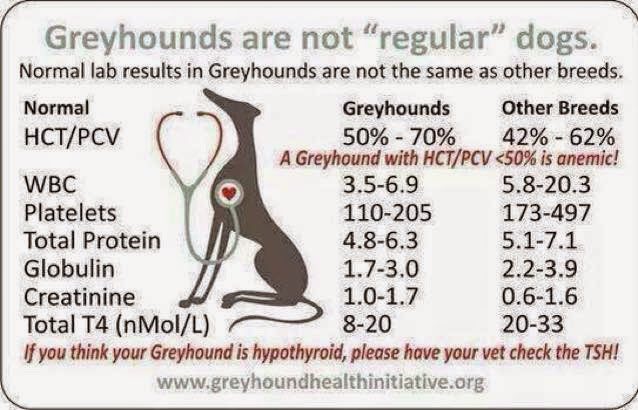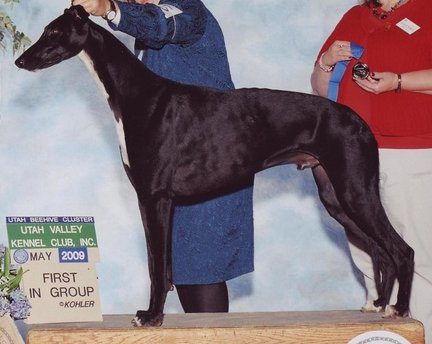
WINDROCK LLC
Recognized by the AKC as a
PLATINUM LEVEL BREEDERS OF MERIT
The ONLY Greyhound breeders so recognized by the AKC

Greyhound Health Issues and Genetic Testing
Our goal at WINDROCK is to produce greyhounds that are a true credit to the breed and to help us reach that,our greyhounds are tested for genetically transmitted diseases. Health testing is a critical component of a responsible breeding program. There is absolutely no good reason for a breeder of dogs not to make use of available health tests--unless of course, it cuts into their "profit margin."
History has revealed time and time again, that there is no line of dogs, cats, horses, etc., free of genetic problems. We as Homo Sapiens suffer from a tremendous variety of inherited ills. Research and responsible breeding has firmly proven that the occurrence of health issues in dogs can be clearly decreased by careful and discerning breeding.
Before a mating is carried out at WINDROCK, a lot of time goes into researching pedigrees, but that is only a small part of it. The proposed parents themselves have to pass rigorous consideration and have proven themselves on the field and/or in the show ring. If possible, they are fully mature (4-6 years) when first bred. Furthermore, breeding stock must be of sound temperament and intelligence as well as being superior representatives with proven show and/or performance records.
WINDROCK aspires to raise healthy puppies that are easy to live with and be just right for families of all kinds. We feel it is important to diversify the small show greyhound gene pool as much as possible by integrating new bloodlines. To that end, WINDROCK has imported several superior foreign greyhounds and sought out the best of carefully health screened coursing and racing lines.
Comparatively speaking, the Greyhound is one of the healthiest of dog breeds and we can thank the Greyhound racing industry for the thousands of dollars of research that has gone into identifying and treatment of medical conditions.
The handsome blue brindle gentleman pictured here on the left is 13 years young and is still climbing mountains. He is a son of our beloved "Bubba", the late great BIS/SBIS Ch Shazam's The Journey Begins JC!
Good genes and great care by owners have resulted in some WINDROCK bred greyhounds reaching advanced ages of 14-16 years, a very good lifespan for a large dog!
The Grim Reaper can come much earlier to Greyhounds HBC (Hit By Car) is a leading cause of death, as are certain kinds of cancers.
WINDROCK Inc greyhounds are very selectively bred~we aspire to breed only superior specimens-- outstanding individuals with proven records of performance
Our breeding stock is usually Champion or Performance titled--individuals with proven records of accomplishment and documented records of health.
Breeding stock is health tested (OFA/CERF, etc) and DNA profiling is done to ensure bloodline integrity. We also test for the newest threat~Neuropathy.


Our Grandma Whisper is shown here accompanying us on a hunting excursion.
Even as a elder dog, she is spry and active.
She tracked and found two deer that hunters had wounded and lost.
Amazing considering Whisper was 14 plus years at the time!
Her excellent condition and health is attributed to good genes and proper care. Whisper passed on just short of 16 years of age. We miss her very much.
Health Screening Information
Each breed has certain health screenings that have been identified to be beneficial for improving the health the breed. The following are health screenings that SHOULD performed on Greyhounds BEFORE mating.
Health screenings on individual dogs can be viewed on the Orthopedic Foundation for Animals (OFA). database at: www.offa.org
At the very least, you should expect that the sire and dam of your Greyhound puppy should be tested for heart, thyroid (OFA), eye defects (CERF), and Neuropathy.
Many breeders strive to obtain CHIC # on their breeding dogs. CHIC means Canine Health Information Center, which is a centralized canine health database jointly sponsored by AKC/CHF (Canine Health Foundation) and Orthopedic Foundation for Animals (OFA) (http://www.caninehealthinfo.org/)
The Greyhound Club of America is in the formative stages of developing a CHIC program, thanks to the efforts of prominent Greyhound breeders Bill Hemple (former President of the GCA) and his wife Shelly Hemple DVM At this time, heart testing is the sole recommendation indicated for Greyhounds by CHIC.
Greyhound Health Issues
Here are a few links to health information about show and racing Greyhounds:

Letter from Dr. Lynda Blythe DVM PhD, co-author, Care of the Racing Greyhound
Three Fatal Diseases in Show Greyhounds by Patricia Gail Burnham [GCA Newsletter, 2002]
Canine Hypothyroidism: Prevalence of Positive TgAA in 503 Laboratory Samples from Greyhounds by Ray Nachreiner et al.
Correlation of Racing and Reproductive Performance in Greyhounds with Response to Thyroid Function Testing by Karin M. Beale et al. [Jl. of the American Animal Hospital Assn., 1992]
More information on hematological characteristics of Greyhounds by W. Jean Dodds [JAVMA, 1995]
Thyroid Hormone and Testosterone Concentrations in Racing Greyhounds with and without Bald Thigh Syndrome by LA Cowan et al [ACVIM abstract only]
Greyhound Health Registry Proposal by Helen Hamilton DVM (GCA Newsletter)
Renal Disease I (March 1991 GCA Newsletter)
Renal Disease II (June 1991 GCA Newsletter)
Renal Disease III (September 1991 GCA Newsletter)
Well-bred Greyhounds can live into their late teens if they are twice blessed with good genes and proper care. Please acquire your Greyhound from a breeder who does health screening and talks candidly about health problems.
Blood Tests
When your veterinarian sends your Greyhound’s blood to a lab, she/he is most commonly asking the lab to run a CBC (Complete Blood Count). This common analysis covers these items:
For a more in-depth look, your veterinarian may also ask for a “Chem Panel” to determine kidney/liver functions. This will give them information about:
Greyhound blood work has enough differences from “other dog” blood work to sometimes make it deceivingly “normal” or “abnormal” if your veterinarian isn’t familiar with these differences. The salient differences are discussed below.
Greyhounds:
Other Breeds:

Greyhounds have significantly more red blood cells than other dog breeds. This elevates parameters for RBC, Hgb (hemoglobin), and PCV/HCT and is the reason Greyhounds are so desirable as blood donors. Most veterinarians are aware of this difference.
Never accept a diagnosis of Polycythemia — a once-in-a-lifetime rare diagnosis of pathologic red blood cell overproduction — in a Greyhound.
Conversely, never interpret a Greyhound PCV in the 30s – 40s as being normal just because it is for other dogs. A Greyhound with a PCV in the 30s – 40s is an anemic Greyhound. Generally, a Greyhound PCV less than 50 is a red flag to check for Ehrlichia.
WBC
Greyhound: 3.5 – 6.5
Other dogs: 6.0 – 17.0
Other Greyhound CBC changes are less well-known. The Greyhound’s normally low WBC has caused more than one healthy Greyhound to undergo a bone marrow biopsy in search of “cancer” or some other cause of the “low WBC.”

Platelets
Greyhound: 80,000 – 200,000
Other dogs: 150,000 – 400,000
Likewise, Greyhound platelet numbers are lower on average than other dog breeds, which might be mistakenly interpreted as a problem. It is thought that Greyhound WBCs, platelets, and total protein may be lower to physiologically “make room” in the bloodstream for the increased red cell load.
Compounding these normally low WBC and platelet numbers is the fact that Ehrlichia, a common blood parasite of Greyhounds, can lower WBC and platelet counts. So, if there is any doubt as to whether the WBC/platelet counts are normal, an Ehrlichia titer is always in order.
The other classic changes with Ehrlichia are lowered PCV and elevated total protein. But bear in mind that every Greyhound will not have every change, and Ehrlichia Greyhounds can have normal CBCs.
T.P. and Globulin
Greyhound TP: 4.5 - 6.0
Other dogs TP: 5.4 - 7.8
Greyhound Globulin: 2.1 - 3.2
Other dogs Globulin: 2.8 - 4.2
Greyhound total proteins tend to run on the low end of normal—T.P.s in the 5.0s and 6.0s are the norm. While the albumin fraction of T.P. is the same as in other dogs, the globulin component is lower.
T4 (Thyroid)
Greyhound: 0.5 - 3.6 (mean 1.47 +/- 0.63)
Other dogs: 1.52 - 3.60
These figures are from a University of Florida study of thyroid function in 221 Greyhounds — 97 racers, 99 broods, and 25 studs — so it included both racers and “retired.” While Greyhound thyroid levels are a whole chapter unto themselves, a good rule of thumb is that Greyhound T4s run about half that of other breeds.
Urinalysis
Greyhound urinalysis levels are the same as other dog breeds. It is normal for males to have small to moderate amounts of bilirubin in the urine.
